The History of Francoy’s Resort
How the cottages on Big Fish Lake became what they are today.
Marcellus Summer Hotels
Grandview – Hayes – Goffs
Island Park – Francoys
Loveridge Hotel
Old Loveridge Hotel is now a private residence and not available for rental.
Written by Current Owner – Don France
The years between the mid 1870’s and the late 1930’s were the hay days of traveling salesmen, artists, performers, and beginning tourism in southwest Michigan. By the 1870’s train companies laid tracks to carry logs and lumber. The trains ran north to Michigan forests, east to Detroit and west to ports on Lake Michigan. A “middle class” began to emerge in the growing cities of America. Most families had been poor. A few families had been very “well off” with servants and summer houses. The Industrial Age brought prosperity to many. Small factories, new processes, catalogs, patents and a rising merchant class emerged in the cities. There was more leisure time for the housewife. Trains provided opportunities to travel. Steamships traversed The Great Lakes carrying iron ore, copper, lumber and passengers. Mackinac Island became a travel destination with a Grand Hotel replacing furs and fish. Travel had become more affordable.
Travelers wanted to leave the sweltering summer heat of the cities and visit the great natural sites in America. Vacation Holidays gained popularity. Transportation by American trains was fast, reliable, comfortable and affordable.
Summer in any large American city was hot, dusty, full of unpleasant odors and noisy. Horses were clip clopping on every street. Few people had screens on their homes. Merchants often lived above their stores or shops. Sounds and odors penetrated open windows and continued through the night. Thousands of horses, chickens, pigs and other small animals brought hordes of insects. Chicago had stockyards and slaughter houses on its west side – and westerly winds. Communicable diseases spread. The lure of clean air was very compelling. Families that could afford it often left dad behind working while mother and children went to the country. Chicago, South Bend and Indianapolis families usually headed north to Wisconsin or Michigan. Resorts were slapped up quickly and cheaply to cater to the train travelers who sought the clean air, lakes and streams of Michigan. The goal was to capture their dollars.

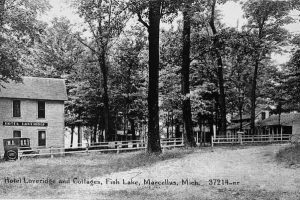

Kline’s Point 1888-1899
The many lakes of southwestern Michigan were just short trips by train. By the 1890’s summer hotels were started around Marcellus, Michigan where many trains passed on the Peninsular Railroad. Several dozen clean, sandy, unspoiled lakes were within easy travel from the depot.
Leah Kline owned an attractive “Point” of land at Fish Lake that was still an Island most of the year. She purchased her Point and “97.80 acres in Section 8” for $1200 from Joseph and Caroline Johnson in March of 1888. The Johnsons had owned that part of the lake since 1875. They purchased it from Joel G. Goff who acquired it in 1836. His descendants later started a summer hotel. The point was just 40 minutes from the train depot by horse and wagon and known as a lovely spot to have a picnic and fish. There were always boys and livery men that hung around the depot when trains were expected. They would take the traveler’s trunk from the train to a wagon. A livery man would whisk the traveler to a nearby hotel in town or summer Hotel at a lake if the proprietor didn’t arrange for transfer himself. Many of these travelers wrote postcards back to friends and relatives of their experiences. These penny postcards bragged of good times. A century later social media would replace the postcard.
In December 1888, Leah Kline died. She provided in her Will that The Point and the 97.80 acre farm surrounding it went to her husband John for his life and then all remainder Interests to her son, William Kline, if William paid $120 to each of his 5 Brothers and sisters. William’s father died. William, born in 1853 in Pennsylvania, paid his siblings although it took him over 10 years to raise the money and collect all their deeds.
37 year-old William Kline constructed a small building on the Point and was available for hire. In July 1895, Kline advertised in the Marcellus newspaper offering rides on a small steamboat for just a few days. The steamboat must have been brought to Marcellus on a train. Rides were offered from Kline’s Point and Grandview across the lake. Sometimes he offered sailboat rides. People held picnics and family reunions on Kline’s Point. Kline sold food and candy from a tree shaded structure to visitors who came on summer days to swim, fish and rent boats.
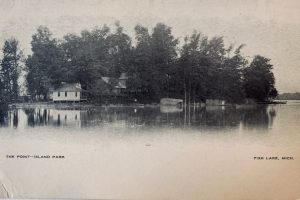
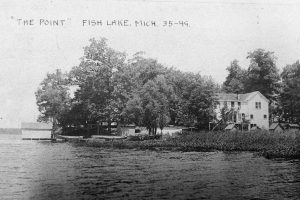
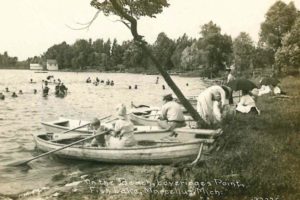
A.C. Steininger’s Grandview Summer Hotel
Andrew Kline, William’s brother, married Sarah Steininger, believed to be a daughter of A.C. Steininger. The A.C. Steininger family began the “Grandview Summer Hotel” across from Kline’s Point by the early 1890’s on the Steininger Farm. They advertised a “dry, healthful” summer hotel with “natural spring water”. Rates about 1900 were $1.00 per day for a room, boats for 50 cents and “rooms including boat $7.00 a week – Phone 45-B”. “Longview” was the name of Steininger’s landing. The writer has a postcard image postmarked 1914 with a wood spoked car pulling a lovely boat and trailer in front of the farmhouse “hotel”. The postcard recites “$1.50/day, $7.00/week, Dairy Table Supplies…Gas Lights”.
A lovely Farmhouse had a 2-story porch, big barn, silo, and beef cattle. Guests would be whisked by “Auto Bus to Trains” on request. Their wood boats were sleek 16 ft. 3-seat affairs with curved rising bows…without the nose seat. Steiningers eventually enlarged the summer hotel on the lake by connecting 2 separate houses along the shore with rooms and a porch between. Steiningers called this lakeside resort “Grand View Summer Hotel”. A DNR public boat launch site now sits at one end of the property. Joe Katona rented boats in the 1970’s from the old house that was one end of Grandview.
Two cow paths led to Fish Lake….one from the south past Goffs to Steiningers and one from the east ending at the lake. The east trail is known today as Loveridge (Gooding) Road. From there a wagon and team could go westward along a sloping meandering path near the shore until wading a short distance in the water and then rising onto Klines’s Point (Island Park). It was an island 20 feet above the lake of over 2 acres with a grove of large trees and beautiful views of unspoiled natural shores. Some years lower water levels exposed a smaller island southwest a few hundred yards. The shore was sandy. The point received winds from 3 directions. Mosquitoes were seldom a bother. Later Kline’s Point would become Loveridge’s Point about 1900 and finally Francoys Resort in 1945.

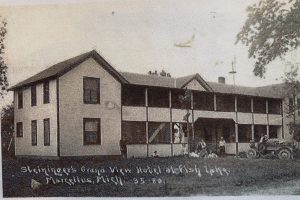
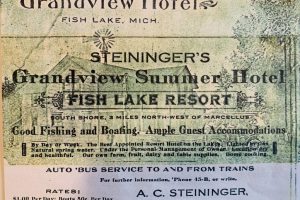
John and Kate Loveridge – Loveridge Point Island Park
William Kline, his wife, Ella (who died in 1936) and 2nd wife Theresa, lived in a farmhouse near the lake for over 50 years. He died about 1951. After 1895 Kline sold The Point and shore land to John and Kate Loveridge. As a young man from New York John made a living as a carpenter. He fought in the Civil War serving as a member of Company A, Thirteenth Michigan Infantry. In 1886 John & Kates’s son, Henry opened a bakery/grocery store in Marcellus which he ran for 15 years. In May of 1899 William and Ella Kline deeded property “from the neck of Kline’s Point” to John Loveridge. Loveridges had already started construction of their summer “boarding house”. They operated it for 3 years until John’s health began to fail. John was known as a sociable friendly proprietor. Kline’s Point began to be called “Island Park” or “Loveridge Point”.
Henry and Rose Loveridge 1900-1929
The Loveridge summer house was enlarged at least twice, the first time when John and Kate’s son and his wife, Henry and Rose Loveridge, made a deal to operate and expand to a Hotel on Loveridge Point about 1900 helping their elderly parents. John died in January, 1901 at age 69.
The expanded Hotel had an artesian well that flowed 2-3 gal. a minute, kerosene lights, stoves but no fireplace. During late winters in the1890’s men cut ice in the cove between Elbel’s Point and the Loveridge Hotel. Horses then hauled lake ice by bobsled to an icehouse just 250 ft. distant from the hotel. Men then shoveled clean sawdust from a local sawmill at Bunker Lake over the ice blocks to insulate and preserve the ice until use when the summer hotel opened. The 1891 icehouse in 2020 is the heart of a lakefront cottage on Fish Lake Drive.
Henry sold his bakery in town about 1900. He tried growing grapes on the slope of the lake. Loveridges built a fine house with a magnificent lake view half way out to the dirt road that ran past the Hayes Hotel. The Loveridge house even featured a small hand operated elevator. More guests could be accommodated at the house.
Periodically, lots along the lake out to the point were sold by John and Kate and later Henry and Rose. Sometimes they purchased them back. Cottages were also sold or repurchased. Dew Drop Inn, a cottage that still exists, was built on the bluff before 1908. The spot where John and Kate (she was known as Katie) first built their boathouse became a cottage site. The white cottage with an old fireplace and mellow knotty pine interior is still called “John & Katie Cottage”.
A 3-story expansion of the hotel westward with the bakery sale proceeds added a ground level 30’ X 66’ dance hall with a small stage and a dozen small guest bedrooms above. Kate and Rose served dinners in the hotel for 25 cents. Wood rowboats were rented for $.50 daily or came with the $1.00 – $2.00 rooms and meals. Ice was available with drinks. A mahogany bar was installed in the room entered from the front door. Beer and whiskey were available. By the late teens The Loveridges installed a large oak glass-fronted Lig-o-nier “Ice Box” refrigerator in the big kitchen. The compressor was put in the basement. Both still are there today.
A wood bridge was added to cross the shallow approach to the island without wading. It was wide enough for a team of horses and early automobiles before a short steep climb 15 feet up to the flat land on top of Island Park.
A man might leave his family at one of the few private cottages on the lake system to go fishing.
The occasional fisherman might row away to fish and somehow end up at the Loveridge Bar for a few libations. How a husband explained his lack of fish to his wife upon return was uncertain. According to one recent elderly gentleman visitor, a few of these “fishermen” had lady friends arrive on later trains and stay at the hotel. The writer supposes these men developed strong arm muscles rowing back and forth to family and hotel interests.
The Fish Lake summer hotels had dinner bells to call guests, each with a bit different pitch. A boater on the lake could tell from the pitch of the bell and the direction of the sound when dinner was being served where he/she stayed. Breakfast was about 7, dinner at noon and supper at 6 o’clock. Fish caught by guests might be served as part of a meal to all the guests staying in the hotel. If the hotel was full of guests the children might be fed at a separate time. The adults ate at large tables in sight of the big kitchen.
While there were a few larger deluxe rooms in the Loveridge Hotel, all those 12 or so built over the dance hall were small. No closets, just hooks and room for a trunk and single bed. Likely there were kerosene lamps in the hall that were lit until all retired. Thin board walls and doors were fashioned about 6 feet apart. The pattern of the rooms is still evident on the old floor
today. Every hotel room had a wash basin, stand and stoneware or ironstone china pitcher. There was but one parlor stove upstairs to take the chill off on cold mornings.
3 or more outhouses were below the hotel on the brink of the cattails down 2 flights of stairs from the upper hotel. However, the guest rooms had slop jars or chamber pots which were used in the night to avoid going “out back”. It was not uncommon for a guest to accidentally tip a pot over after use in the dark. The sound on a painted wood floor must have resonated through nearby guest rooms.
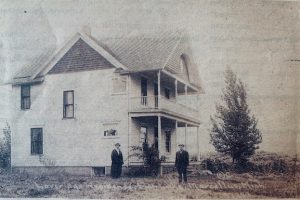
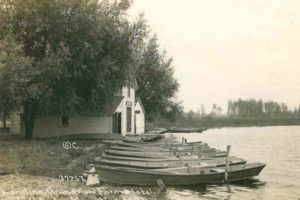

Melville’s Purchase The Hayes Hotel
Gathering these pots to empty every morning, clean rooms and wash bedding plus delivery of fresh pitchers of water were among the least desirable jobs for a hotel worker. Lucile Melville verified this to the writer. As a young wife her job title included the above at the Hayes Hotel. Husband Stub and his brother John ran the hotel with the help of both wives in the 1940’s. It was really the wives who made the room rental business operate day to day. The women were relieved when their duties were later lessened. One day the Melville brothers just removed the 2nd story of old Hayes Hotel rooms. The couples then concentrated on the bar and restaurant below. The Melville Family ran “Melvilles” successfully for several decades. Stub Melville’s band often provided the musical entertainment. The Melvilles also developed plats and created numerous lake front and back lots along Red Run Road.
Before Melville’s the Hayes Hotel had chickens nearby producing eggs for the hotel guests’ breakfasts. The Hayes Hotel in the 20’s advertised 25 cent chicken dinners. Mrs. Hayes cooked and served family style. In earlier years the drain from the Hotel had run straight to the lake. The Hayes family owned 60 acres North of Gooding Street for several decades.
In the 1920’s Hayes had erected their Rainbow Dance Pavilion on the north side of the road. The Dance Pavilion drew people from far and wide by motor car for the music and dancing. Dance contests drew large crowds – far more than the capacity of the Loveridge dance hall. The building had a curved roof like a Quonset hut and was elevated on short pylons off the ground with parking to the north towards the lake. By the early 1940’s the pavilion was gone.

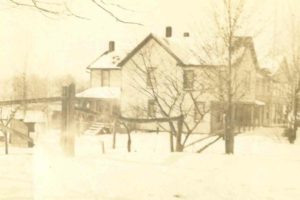
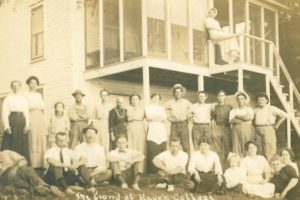
Goff’s Hotel
Florence Hayes, the proprietor of her hotel, shared a large lake lot with the Goff’s Hotel (Goff House) where their boats were kept and the guests of both swam, perhaps the best beach along the lake. The beach was 60 yards south west of where the road ends at the lake. Cyrus Goff, the proprietor of the Goff hotel, died in 1921. The writer suspects his daughter, Florence, may have been Florence Hayes. Emma Goff and her daughters Ida and Florence continued to offer guest rooms after 1921. The empty old “farmhouse” still stands on Steininger Street south of Loveridge. There are 4 bedrooms up plus a sitting room and 6 rooms down. There are still 2 old chimneys indicating 2 stoves served the “hotel”. The barn is gone but the house and porch still resemble the postcard images from the teens. There was a large root cellar in the Michigan basement. The parcel was 40 acres in the 1920’s but today is just 1 or 2.
In its prime the Goff’s Summer Hotel had a separate “Summer Kitchen” that served the Guests.
Summer kitchens were common in the southern states. They offered 2 advantages (1) to keep the heat out of the house in the hottest weather, and (2) to reduce the danger of fire to a wood frame house by cooking in a separate small structure. Likely Goffs were the first to offer guest rooms with boats at Fish Lake. The couple married in 1874.


Entertainment at Island Park
During warm afternoons and after dinner the lady guests and daughters often sat on the two- story screened front porch of the Loveridge’s Hotel or the 2nd two story porch off the dance hall and rooms above. Guests frequently stayed several weeks to avoid discomfort at home in the hot city. Within a few days the guests staying in the hotel knew everyone staying in the cottages. They conversed on the lawn and over meals. The screened porches provided ladies a place to sit, feel a breeze and talk. The ladies made several clothing changes during the course of a day and evening. They dressed in late afternoon for dinner and for dances. Ladies appearing on early Island Park postcards (often available on ebay) are seen in full length layered dresses even in warm weather. The styles of attire didn’t change much for ladies until the early 20’s. Swimming suits were designed more to hide a figure instead of celebrate it. Relaxed resort attire would come about rapidly by the late 1920’s.
The summer hotels usually had bars and periodic entertainment. Entertainers travelled from town to town by train if they could afford it. In Marcellus these entertainers frequently performed upstairs in the Centennial Hall on Main Street and could be engaged for a night at a summer hotel. Many of these professional actors, orators, musicians, singers, magicians and speakers on issues of the time were of high quality.
Money to cover the proprietor’s overhead and expenses had to be made in 10-12 weeks for the year. On Saturday nights in the teens, 20’s and early 30’s a small band would regularly set up on the tiny stage in the 30 X 66 ft. dance hall at the Loveridge Hotel. People from the village and surrounding cottages would dance way into the night until the musicians would tire. A few tips could continue the music. In 1914 the hotel had a “privy” about 70 feet from the dance hall door (today Park Model sites 12-13). Entry from the lake side on the bluff would have offered a lovely evening view of the lake… and privacy. Today Mrs. Bruington grows abundant flowers in about that location.
In the 20’s a tiny inside lavatory with stool and small sink was built on the dance floor adjacent to the 8 X 8 band stage. The outside privy disappeared. The lavatory was only 30 X 36 inches with a narrow door. A person might have to duck a band member’s elbow to enter. One can imagine users might wait to flush until the music was the loudest.
Men gathered at the bar in the adjoining room or sat at tables playing cards. The bar furnished beer and a few brands of whiskey. The resort brought people from around the lake even if they did not stay at Island Park. By midnight horses, buggies and early cars would take tired dancers back to their homes, cottages and other summer hotels. All who were staying at Island Park in the hotel and cottages would collapse into beds until it was time for breakfast. There still is an old piano left at the hotel. Post Cards featuring photos of the Summer Hotels were provided guests who were encouraged to write friends of their experiences. The hotel proprietors knew these postcards were great advertising and would be mailed all over the United States.
Richard Olsen still remembers when he was a boy and visited Island Park and the Loveridge Hotel. Richard and his grandmother crossed a simple wood bridge from the mainland to Island Park. They stayed in one of the lake cottages. Olsen, a skilled carpenter, recently reconstructed the narrow Internal hotel stairway to the upstairs, built a lovely 2 – room library and remodeled all the cottage kitchens and bathrooms. The wood bridge is now a faint memory. The Melvilles hauled in many truckloads of fill in the 1950’s for the Francoys to replace the bridge and fill the nearby lowlands.
There was no livery at Loveridge’s Hotel. While a few horses were kept near the Loveridge house, men and boys with horse teams could be counted upon to meet the trains and transport guests and trunks to and from The Loveridge Hotel, Hayes Hotel, Goff’s and Grandview until the 1920’s when cars and trucks took over as transportation. Mr. Steininger often transported his Grandview Hotel guests to the train depot himself after payment of the bill as did the others. The depot was east nearly a half mile from its later location. Most Marcellus visitors stayed at one of the 3 hotels in the village but it was cooler at the lake in midsummer.
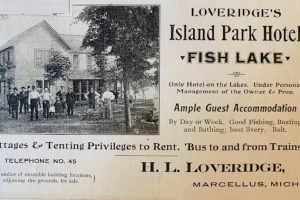
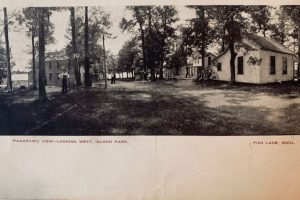
Before Outboard Motors
Until at least 1912 fishermen had to row the heavy hotel wooden boats with oars. A few boats on the lake had sails. A man named Evinrude invented a workable detachable outboard motor in 1909. Until then heavy single cylinder inboard engines were the only option. Still few could afford this luxury. By 1921, the Johnson Brothers were making lightweight outboards. Wooden boats were redesigned to accept the screw down grip of outboard motors on the sterns. The Evinrude and Johnson motors were reliable. Every fisherman wanted one. The motors became common on Fish Lake by the late 1920’s. Outboards would change little from the 20’s to the late 40’s. By 1950 many affordable outboard brands were being manufactured.
Fish Lake becomes Big Fish Lake
Fish Lake was called that because it had very good fishing from the 1800’s until the 1950’s. The lake connected with east and west Saddlebag Lakes, Finch Lake and by a good stream westward under a bridge past the mill pond, a saw mill, (later a grist mill) over a small dam and into Bunker Lake.
To distinguish Fish Lake from many other “Fish Lakes” in Michigan local residents renamed it Big Fish Lake. It still has a long natural shore line with wetlands on one side. Today the water level is artificially maintained by a structure in the stream from Finch to Bunker preventing water passing below a specified level. A channel through the Melville’s wetlands connects the Saddle Bag Lakes to Big Fish Lake. It is wide enough in places for 2 fishing boats to pass.

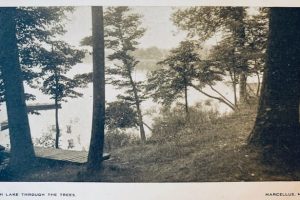
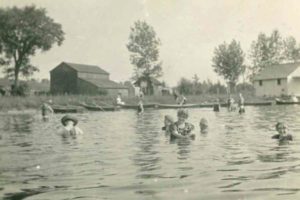
The Vanishing Massasauga
Big Fish Lake harbors one of the lessening populations of the small Massasauga rattlesnake. The author captured one with 11 rattles near the door of the old hotel, put it in a bag and deposited it safely back into a nearby swamp about 5 years ago. The reptiles are endangered and protected by law. There are no recorded deaths in Michigan from the small snakes although their venom is rather toxic but fangs short. This writer can testify to that after being bitten on the thumb as a teenager. His right hand and arm swelled up like a football before antivenom was mixed and injected. The bite was very painful. A Kalamazoo nurse was most alarmed by the bite …and even more when the writer offered to go get the pet snake from a box on the seat of his car if she doubted the source of the swelling… that was just a little one of 20-23 inches.
Massasaugas like to swim. The writer sees 1 or 2 every summer. The heads are very distinctive. A very large one (a female probably) can be 30 some inches and 1 ½ inches thick. The old one the writer relocated with 11 rattles was less than 33 inches and did not have a very loud rattle. Frequently non venomous local water snakes (natrix sipedon) are confused with the rather rare small rattlesnakes. Both species suffer from declining populations. There is no reason to harm either variety.
Prohibition
In 1919 the United States adopted the 18th Amendment – Prohibition – The Federal and local governments struggled to comply with the times and enforce the “no alcohol” laws. In many rural areas and small towns local police sometimes looked the other way. The small lake resorts depended on giving the guests what they wanted…and they wanted beer and liquor. Many Summer Hotels, including Loveridge’s Hotel at Island Park, had to have alcohol available or the customers would go elsewhere. So, Loveridges usually had beer and whiskey. Some was brought from Chicago. Some came from Canada via Detroit. There was always an illicit source someone knew to stock Michigan resort bars for their customers. It was a bit of a game during prohibition to keep the availability of alcohol quietly known to the guests and yet not broadcast locally. Seldom was there a “dry” evening at Loveridges between 1919 and the passage of the 21st Amendment in December of 1933 ending Prohibition. It was likely the same at most other nearby summer hotels.
Changing Times – the Resort Era wanes
The Summer Hotels lasted as long as the good times lasted. Dusty city streets became paved. Animals and fowl no longer occupied the residential neighborhoods. Air conditioning became affordable. Airplanes and automobiles replaced the trains for travel. Good highways and reliable automobiles changed the way people lived their lives. The Depression, then World War II and changing expectations for resort amenities ended the era of the small Southwest Michigan summer hotels.
Places like The Loveridge Hotel were thrown up quickly only for summer use and not designed to be occupied winters. For instance, the hotel only had 1 small closet from 1900-2013. Summer Hotels fell into disrepair and could not compete with larger competitors. Most closed in the Late 30’s or during WW II. Many burned. Some were eventually remodeled into lake residences. A few resorts along Lake Michigan shores grew in size, remaining popular into the late 20th century. Owners tried to make ends meet by operating primarily as restaurants but the old local summer hotels weren’t designed to meet the increasing health codes and too much maintenance was required. There was little business in winter. The Cass County lake districts of today may have temporary summer weekend populations totaling 200 – 250 thousand from mid June to mid August but a county population of under 60,000 the rest of the year.
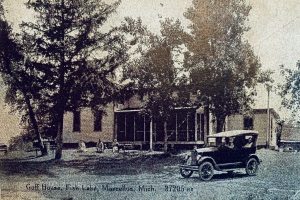
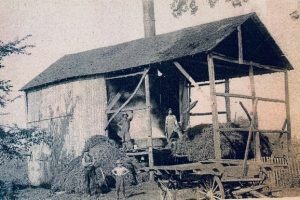
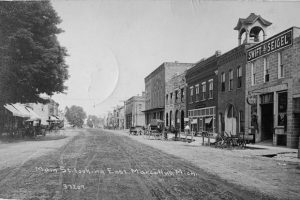
The Francoys
Henry Loveridge died an early death at age 52 in 1910. After 1910 Rose ran the hotel. After Rose’s death in 1929 Burt T. Loveridge, Henry and Rose’s son, previously of Ottawa, Illinois operated the Loveridge Hotel but not very successfully. The Hayes Dance Pavilion would have drawn away the crowd. Burt was 48. Rose left a 2nd husband, Will Perrin. A court fight over the husband’s rights was settled by Burt paying Will Perrin $5000. The Probate Court then awarded Burt his mother’s “22 room Hotel”, contents, “ 7 Summer Cottages” (Roseburt, Dew Drop Inn, Henry L, John Katie (new), Bi Jo, Rest Cottage and White Wings) all furnishings, 8 steel boats, 7 wood boats, A 1927 Dodge sedan, garage building with stalls for 10 cars plus “the land where it stands”, a 7 room frame house, garage behind, and 7 acres under his mother’s Will. In earlier years Burt had been an “advance man” for the Forepaugh and Sells Circus. In 1945 Burt and his wife, Laura sold The Point, Hotel and just 4 Cottages and 4 boats to August and Mary Francoys. The name of the Hotel on Island Park changed to Francoys Resort.
Mr. & Mrs. Francoys were hard working people. They made many improvements, removed the upper screen porch of the 50 year old Hotel, lowered the hotel roof line above the Dance Hall by 6 feet eliminating the overhead guest rooms and modernized the cottages all while raising a family. August and Mary’s daughter Marguerite still rented 5 or 6 lake cottages and ran a small summer trailer park on low land behind the old hotel until her death in 2007. Marguerite’s family tried to continue but the resort failed and eventually lost all licenses. They put the property up for sale for several years but no takers. In 2013 the Health Department required the resort close.
The Frances
In late 2013 Don and Pam France with a friend, Ben Bartson, took a look at the dilapidated Francoys trailer park, the hotel with a large hole in the roof where rain poured in and the run-down cottages. They loved the views and recognized the potential. Don was a local lawyer and a pilot for 50 years but health compelled him to consider a new direction for his energies. They first considered razing everything and developing several lakefront residential sites on the 562 feet of lake frontage. Then Don began to learn of the history of the resort and thought it may be worthy to save. His wife on the other hand saw a bottomless money pit. The budget for restoration soon had to be doubled…then increased again. And again….and finally again.
Don bought the 9 old house trailers from long time guests, scrapped the trailers and filled 22 flatbed trucks with debris, refuse, dead trees and 150 plus bags of garbage found in the dance hall. He brought in engineers, contractors, and carpenters and went to work himself rebuilding the old buildings. After meeting with inspectors the first to go were the water system, sewer system and the well. Next, roofs were replaced to keep out the rain. Then the interiors. Landscaping was last. Bathrooms and kitchens were gutted and replaced. An electrical contractor, heating contractor and plumbing contractor worked for 6 weeks each. Furnaces and air conditioning were added. Fresh topsoil reestablished the possibility of growing a lawn where none existed. Old flowers and bushes were discovered and nurtured. New ones were added.
5 years later Francoys had a small full hookup RV Park with sites rented by the season. Five 2-bedroom rental cottages were restored and rented weekly during summers. Don was able to persuade Vern and Linda Bruington to remain in residence and act as hosts. The hotel has become France’s summer cottage despite having a cabin on a northern lake they seldom find time to visit and a 2nd cottage on another lake. Their Florida home was sold recently as the Frances debate retirement. Old guests are returning and sharing stories and photos of vacations at the Point back to the 1940’s. The Francoys guests often remark about the Point’s serene setting. A few tall trees from the mid 1800’s still grow in the hotel circle.

The Francoys Swallows
A colony of barn swallows took up nesting rights as soon as Henry Loveridge finished the Dance Hall addition in 1901. He dug a lower level basement into the island bluff leaving the south side under the dance floor exposed to the elements. Long large hand hewn beams supported the hotel addition. This was seen as an inviting opportunity to a flock of barn swallows. Swallows require precise conditions for their mud nests and the beams were just right. They annually returned to nest and raise their young. Swallow colonies are on the decline today.
In 2014, Don France decided the exposed lower level needed to be walled in. It would afford his elderly friend Vern Bruington, the maintenance man for the resort, a location for a fine shop. However, Vern and Don forgot to clear construction plans with the swallows. The wall went up. But when Vern opened his shop door he was bombarded with swallows wanting to go in and out to their traditional nest sites. Vern was not a patient man. The swallows showed their disfavor with Vern’s takeover by leaving many deposits on the resort tractor and Vern’s table saw, tools, lumber and work bench.
Vern was wise enough to know he needed to negotiate with the swallows…and soon a plastic sheet was dropped from the shop ceiling with Vern retaining 50% of the shop for himself. Vern opened two windows at the swallows’ end of the shop. Since then on summer evenings the swallows can be seen flying in and out the windows, swooping and diving to catch mosquitoes over the lawn behind the hotel. A swallow may capture 700 mosquitoes in a day. So, peace appears restored at Francoys Resort, the last of Summer Hotels on Big Fish Lake. The swallows have been in residence for over 100 years. Vern a mere 15. Many thought it kind of the swallows to meet Vern half way.